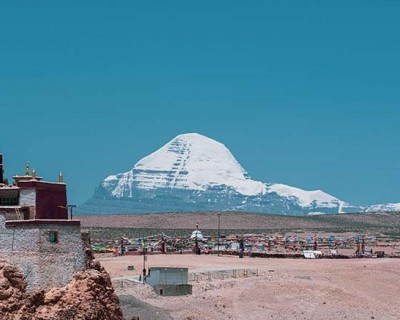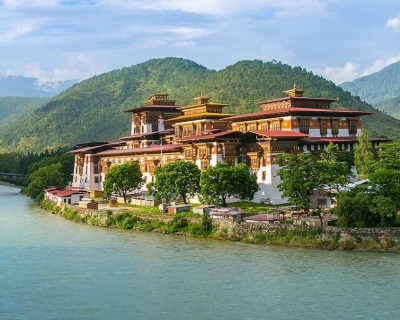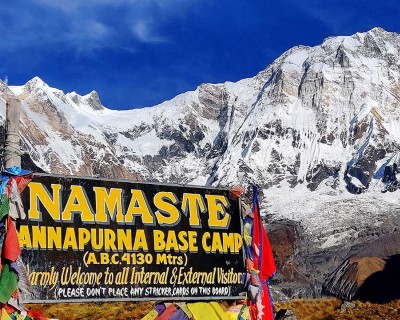Island Peak gained popularity all over the world due to the British expedition team who were scaling Mt. Everest in 1953. The team expedition team made history on 29th May 1953 as Tenzing Norgay Sherpa and Hillary Clinton became the first-ever people to reach the summit of th tallest peak in the world. The 1953 expedition team used Island Peak as the technical training ground and to strategize their acclimatization plans; thus, these two peaks of the Nepali Himalayas share a great history of the remarkable achievements of humanity.
Spring Season (March, April, and May): Best Time for Everest and Island Peak Climbing
Spring is the most popular season in the Nepali Himalayas for both trekking adventures and mountain expeditions. This season accommodates the climbers with warm-pleasant temperatures, and the weather is stable, with mostly clear blue skies throughout the day. Similarly, the natural beauty of the Himalayan region is at its peak during the spring season, and the fresh, lush trekking trails with stunning visuals enhance your journey. Enjoying the epic Himalayan vistas across the bed of colorful wildflowers and beneath the deep blue sky is a magical experience in every sense.
Spring season also sees a surge in the number of trekkers and mountaineers in these mainstream routes unlike any other season due to its comfortable and visually appealing scales. If you are a nature lover or wildlife admirer, this season will unveil the Himlayan flora and fauna at their natural habitat, savoring the sweetness of nature’s peak point.
The temperatures at the trekking trail during the spring generally range around 20°C; during the warmer days, it can peak upto 25°C. However, in the alpine zones (above 4,000 meters), the temperatures are generally cold and can drop upto -15°C.
You might like to read:
Autumn Season (Septemeber, October, and November): Best Time for Everest and Island Peak Climbing
The Autumn season is another ideal and best time for Everest and Island Peak Climbing. This season, like spring, also boasts the most stable climatic conditions and has a low precipitation rate; thus, the trekking trails are dry and easy to walk. With the comfortable. You will also have it easier during your mountain expedition as you don’t have to deal with challenging high-altitude phenomena like high-wind blizzards and heavy snowfall like the off-seasons.
Autumn is also popular for offering the most spectacular views of the Himalayan vistas due to the clear weather; you can enjoy the breathtaking views of the pristine peaks till the end of the horizon. This season has an incredible festive ambiance as it is the core part of colorful celebrations in the country. Some of the biggest festivals in this Himalayan nation, like Dashain, Tihar, Indra Jatra, Pachali Bhairab, Mani Rimdu, etc, are celebrated during this season.
You can expect the temperature at the lower Everest region to average around 17°C during the daytime and can reach as high as 20°C. It won’t be too hot or too hold during your trekking part in this season. The temperatures can drop to -15°C as you gradually start ascending to an altitude above 4,000 meters.
Other Season Considerations for Everest and Island Peak Climbing
Besides the peak seasons that are the best time for Everest and Island Peak Climbing, these expeditions can also be done and have been done during the off seasons like monsoon (June- August) and winter (December- February). As these seasons don’t have stable climatic conditions, they are not favorable periods to enjoy a comfortable journey, and due to added weather challenges, the journey becomes even more physicall and technically demanding. Thus, climbers who don’t have significant mountaineering experience are not recommended to take on these expeditions during the off-season.
Everest and Island Peak Climbing During Monsoon (June, July and August)
The monsoon is one of the challenging periods for these iconic Himalayan expeditions. As this is the peak point of the summer season, the temperatures of the lower regions spike and continuous rainfall makes a mess out of the trekking route. You will have to navigate yourself along the slippery and muddy trails during your high-altitude journey. Similarly, the lower trails are infested with leeches and mosquitoes, which can make the experience discomforting and irritating at times.
Similarly, the risk of natural distaste like landslides, flooding and lighting storms is pretty high during the season. Thus, you will have to be mindful of the weather updates and be on alert while navigating the risk-prone areas. You will also need to pack appropriate gear and outer layer to tackle the slippery trails and the rainfall during the trekking part.
The temperature of the trekking trail during the monsoon season usually hovers around 23°C. During the peak point under the clear skies, the temperatures can spike from 30°C to 32°C. However, after reaching the alpine zones, the temperatures start to drop gradually and reach lower at -5°C.
Everest and Island Peak Climbing During Winter (December, January and February)
Although the mountain and trekking expedition in the Everest region in the winter season is not as risky as the monsoon, it is definitely physically demanding. The winter is the coldest season in the Himalayas; thus, you will need to pack heavy layers and appropriate gear to keep yourself warm during the expedition. Similarly, the trekking trails in the higher regions are completely covered in snow, which means you will have to put an extra effort just to navigate the trekking trails.
During the winter season, the troublesome phenomenon of bad weather, like high winds, heavy snowfalls, blizzards, and even avalanches, are at their peak point. So, if you are not careful on high-altitude expeditions like Everest, the bad weather challenges of the winter seasons can even cost lives. Mountain expeditions in this season are only recommended for climbers who have a significant year of mountaineering and risk handling/management experience.
The temperature of the lower trekking region during the winter is around 10°C on average. During the warmer days, the temperature can rise upto 17°C however, at night time, the temperatures fall upto -20°C at the alpine zones.
Weather Pattern on Everest and Island Peak During High Seasons
The Island Peak is one of the incredible trekking peaks in the eastern Himlayas and is at an elevation of 6,189 meters (20,305 feet). As this Himalayan peak doesn’t have a significant altitude and is under 6,500 meters, there isn’t that much temperature fluctuation at its summit. The temperatures at the summit of Island Peak can average around 10°C during the spring season and can drop upto -10°C at nighttime. Similarly, during the autumn season, the temperature is around 5°C during the day period and can fall to -20°C at night.
As for the summit of Mt. Everest, the tallest peak standing on the planet, spring temperatures generally hover around -0.9 to 4.7°C during the daytime. The night temperature, on the other hand, can hit the maximum low of -33°C. Likely, the temperature at the summit of the peak is between -1.5°C to 5°C during the autumn season during the day. You can expect it to drop to -31°C during the nighttime and early mornings.
Helpful Tips for Planning Everest and Island Peak Expedition
Hire Service of Reputable Agency
While booking packages for these incredible Himalayan peak expeditions, instead of going for the cheaper options, you should hire the services of a reputable company. Buying packages from reputable companies will ensure that you can enjoy a comfortable Himalayan adventure, and the services will be offered in the package.
There is a high chance that the packages that are valued significantly lower than the aggregate market price don’t offer quality services or have many hidden charges. So, you should carefully inspect every component of the package and check reviews of the company before booking it.
Note: If you want to avoid paying extra, you should book your services with Nepali agencies rather than going through a third-party. Only registered Nepali companies are allowed to manage operations in the Nepali Himalayas.
Physical Preparation
Physical preparation is a must when it comes to high-altitude adventures like mountain expeditions. You will have to traverse across rugged and challenging trails of the Himalayan region before making your ascend on the alpine slopes, traversing across the rock, ice, and snow segments to the summit. Thus, for the physically demanding part of the journey, you will need to make enough preparations. Unlike the trekking adventures, you will have to be in your best shape for the mountain expeditions, especially if you are ascending a peak that rises above 8,000 meters.
The majority focus of your physical preparation should be on your endurance and stamina level. You can also do some practice hikes near your home to preparing the steep sections that you have to overcome during your journey. Similarly, mountaineering skills are a must for these sem-technical peaks of the eastern Himalayas. Although you can climb Island Peak with sufficient training, and this expedition doesn’t require you to have any previous climbing experience, for an Everest expedition permit, you need to climb a Nepali Himalayan peak in at least 6,500-meter class or higher.
Packing Checklist for Journey
Just understanding the best time for Everest and Island Peak Climbing is not sufficient when it comes to these Himalayan expeditions. You also need to be prepared for the different climatic zones that you trek across during your expedition. The tropical (below 1,000 meters), sub-tropical (1,000 to 2,000 meters), and temperate (2,000 to 3,000 meters) zones that you will trek across during your expedition on the warmer scale during the peak season.
However, as you ascend to the sub-alpine (3,000 to 4,000 meters) and alpine zones (4,000 to 5,000 meters), the temperatures start to drop gradually. As you ascend to tundra/trans-Himalayan (above 5,000 meters), the temperatures steeply fall to minus degrees Celsius. Thus, you need to prepare the right layers for the different climatic zones you will pass across and will need an extensive set of mountaineering gear to complete your expedition safely and comfortably.
Here is a detailed article: Packing list for Everest Base Camp Trek with Island Peak
Understanding the Risk of Altitude Sickness and Preventions
While doing a high altitude adventure, especially in the alpine zones where acclimatizing can be difficult due to cold climate conditions. Thus, you will need to understand the risks of various forms of altitude sickness that come along with your high-altitude journey and how to mitigate them. Enough acclimatizing period is a very crucial factor when it comes to high-altitude Himalayan expeditions. You need to give your body enough time to acclimatize to the alpine altitudes before pushing for further to even higher altitudes.
There are basically three types of altitude sickness: the milder form of altitude sickness is known as Acute Mountain Sickness (AMS), and a slightly milder form is called High Altitude Cerebral Edema (HACE), which causes the brain to swell. The final and last stage of mountain sickness is called High Altitude Pulmonary Edema (HAPE), where fluids leak from the blood vessels and accumulate in the lungs. During your expedition, you need to understand the risks and symptoms of these conditions and follow appropriate measures to avoid any kind of inconvenience.
Hydration and Nutrition Monitoring
During your iconic Himalayan expeditions, you will spend a significant amount of time on the mountain, eating and resting at the teahouses on the trails and camps on the mountains. Thus, it is important to monitor your hydration and nutrition during your iconic adventure. If you don’t eat a balanced diet to fuel yourself for the expeditions, it can weaken your body and expose you to the risks of not just altitude sickness but other general illnesses as well.
Similarly, during the long hours of trekking and scaling, you will lose a significant amount of boy water level. To keep the water level of your body at an optimum level, you will need to drink at least 3 to 4 liters of fluid per day. This will help you to move around more comfortably and mitigate the risks of altitude sickness. You should also pack nutritious snacks, energy bars, and drinks for a quick energy boost during the journey.








